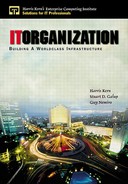Chapter 4. Case Studies
For years we've known of the issues with client/server computing as highlighted in Table 2-1. For years we've also been pleading with IT management all over the world to do something about these problems before it's too late. It's obvious we haven't succeeded in communicating the urgency of the problem. Let's give it one more try.
If IT management wouldn't listen to us before, we thought eyes might start opening if they saw case study data from 40 Fortune 1000-class companies. Sometimes it's easier to look objectively at someone else's organization to see the blatant problems … easier than looking at one's own problems.
These case studies are from companies spanning across different industries, including finance, manufacturing, media, transportation, retail, etc. We looked inside some of the largest, most established, and well-known companies in the world. We also looked at a few smaller yet fast growing companies, such as Internet service providers and other Internet-related companies.
Here we share the data that took almost two years to compile.
Our program to assess IT organizations was started because we knew of the ongoing frustrations and problems IT management was having in supporting client/server computing. We believed that, based on our experience of running client-server computing, we could provide valuable insights to others on how to manage their organizations. We have extensive experience running legacy and client-server shops.
Seventy-five percent of the companies we visited also had mainframe environments. What would any red-blooded IT professional do but compare RAS in the two environments? The results are not surprising. The mainframe would win hands down. Every organization reported better RAS statistics and experiences with the mainframe compared to client-server computing. It was the same in the US as in Asia or Europe, the same in manufacturing companies as at the movie studios as in aerospace firms. The simple truth is that no one has the same frustrations in the legacy world as in the client/server world.
Everywhere we've gone we've heard the same story, namely that the client/server environment isn't as stable, or as disciplined, or as secure as the older legacy environments. If we were CIOs from one of these 40 companies, we would say the same thing they did because they, like us, had success with RAS in their mainframe legacy environments of yesteryear. We've had success with RAS in legacy environments and with client/server computing. Thus, we were confident of our ability to consult and offer our vision and guidance.
But we all know that talk is easy. The actual building of an infrastructure with RAS takes many years to get it right. In the legacy environment we focused on the infrastructure first and it still took years. Do you remember who was directly involved with every aspect of developing a state-of-the-art infrastructure? You got it, the MIS manager who was the 1970s version of today's CIO. The MIS manager's office was near or next to the Data Center, that temple of RAS. There wasn't a day that went by that he or she didn't put on their white gloves and inspect the beautiful glass house. It was their showcase to the world. All visitors (even vendors) received a tour whether they asked for one or not. They had rules—rules that provided RAS—and rules that were a bit excessive. There better not be a speck of dust, waste in the garbage can, or a cable lying around where it shouldn't be, or heads would roll. Yet, metrics were abundant and accurate.
Let's get back to the case studies. Why did we wait until after 40 site evaluations to write about this? The proof is in these assessments. Forty for 40, they all depict major flaws in the organization structure. Table 4-1 points out these organizational-related problems and their impact. These problems are highlighted in the table to bring you visibility and awareness of the mess these computing environments are in today. Unreal, isn't it! If we were to see this for the first time we probably wouldn't believe it either. The same issues and problems over and over again from company to company. Some have legacy environments and some don't. But what is apparent is that the infrastructure has truly taken a back seat to developing new systems. It's really a mess out there. Chances are executives wouldn't agree with us—they would never agree on something like that. They may change their minds when they see the data and the list of these 40 elite corporations. Then maybe they would start questioning their own IT computing environments.
